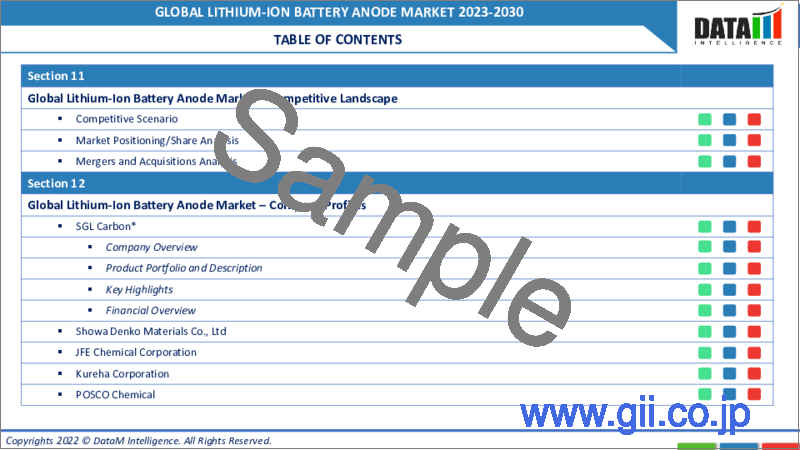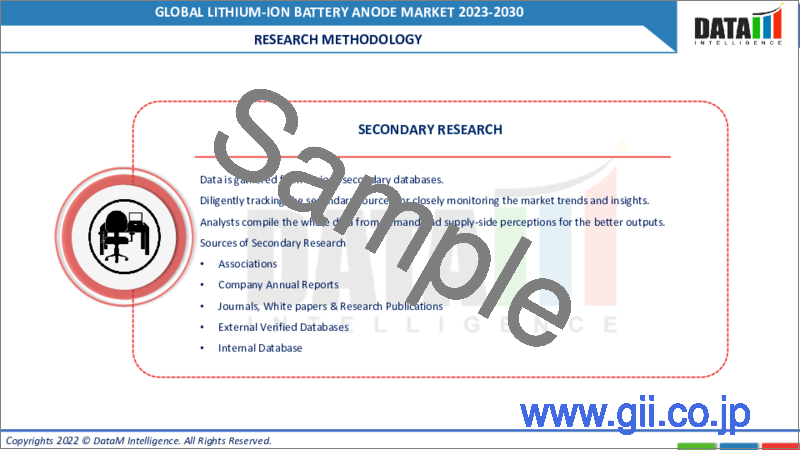|
|
市場調査レポート
商品コード
1082979
リチウムイオン電池アノードの世界市場:2022年~2029年Global Lithium-Ion Battery Anode Market - 2022-2029 |
||||||
|
● お客様のご希望に応じて、既存データの加工や未掲載情報(例:国別セグメント)の追加などの対応が可能です。 詳細はお問い合わせください。 |
|||||||
| リチウムイオン電池アノードの世界市場:2022年~2029年 |
|
出版日: 2022年06月03日
発行: DataM Intelligence
ページ情報: 英文 195 Pages
納期: 約2営業日
|
- 全表示
- 概要
- 目次
当レポートでは、世界のリチウムイオン電池アノードの市場を調査し、市場の定義と概要、新型コロナウイルス感染症 (COVID-19) およびその他の市場影響因子の分析、法規制環境、市場規模の推移・予測、各種区分・地域/主要国別の内訳、競合環境、主要企業のプロファイルなどをまとめています。
目次
第1章 世界のリチウムイオン電池アノード市場:調査手法・調査範囲
第2章 世界のリチウムイオン電池アノード市場:市場の定義と概要
第3章 世界のリチウムイオン電池アノード市場:エグゼクティブサマリー
第4章 世界のリチウムイオン電池アノード市場:市場力学
- 市場に影響を与える要因
- 促進要因
- 抑制要因
- 市場機会
- 影響分析
第5章 世界のリチウムイオン電池アノード市場:産業分析
- ポーターのファイブフォース分析
- サプライチェーン分析
- 価格分析
- 規制分析
第6章 世界のリチウムイオン電池アノード市場:COVID-19の分析
- COVID-19:市場への影響分析
- COVID-19渦中の価格ダイナミクス
- 需給スペクトル
- パンデミック時の政府の市場関連イニシアチブ
- 製造業者の戦略的イニシアチブ
- 総論
第7章 世界のリチウムイオン電池アノード市場:材料別
- 天然黒鉛
- 人工黒鉛
- シリコン
- リチウム化合物・金属
- アノードバインダー
第8章 世界のリチウムイオン電池アノード市場:電池製品別
- セル
- バッテリーパック
第9章 世界のリチウムイオン電池アノード市場:エンドユーザー別
- 自動車
- 蓄電
- 航空宇宙
- 船舶
- その他
第10章 世界のリチウムイオン電池アノード市場:地域別
- 北米
- 欧州
- 南米
- アジア太平洋
- 中東・アフリカ
第11章 世界のリチウムイオン電池アノード市場:競合情勢
- 競合シナリオ
- 市場における位置づけ/シェア分析
- M&A分析
第12章 世界のリチウムイオン電池アノード市場:企業プロファイル
- SGL Carbon
- Showa Denko Materials Co., Ltd
- JFE Chemical Corporation
- Kureha Corporation
- POSCO Chemical
- Nippon Carbon Co. Ltd
- NEI Corporation
- Tokai Carbon Co., Ltd.
- Jiangxi Zhengtuo New Energy Technology
- Jiangxi Zichen Technology
第13章 世界のリチウムイオン電池アノード市場:重要考察
第14章 世界のリチウムイオン電池アノード市場:DataM
Market Overview
The global lithium-ion battery anodes market size was worth US$ XX million in 2021 and is estimated to reach US$ XX million by 2029, growing at a CAGR of XX% during the forecast period (2022-2029).
A lithium-ion battery is a rechargeable battery in which lithium ions move from the negative electrode to the positive electrode via an electrolyte during discharge and back again during charging. Lithium-ion batteries use a lithium compound as the material for the positive electrode and graphite for the negative electrode. Lithium-ion batteries have greater energy density and hence, find various industrial applications. The batteries in electric vehicles to smartphones, tablets and other types of electronics.
Lithium-ion batteries have a high energy density and low self-discharge. The anode substrate is coated with an active material. The active material of the anode enables the flow of electric current through the external circuit while allowing the absorption and emission of lithium ions released from the cathode. Lithium ions are stored in the anode and not the cathode when the lithium-ion battery is charged.
When the conducting wire connects the cathode to the anode during discharge, lithium ions naturally flow back to the cathode through the electrolyte. The electrons separated from the lithium ions move along the wire, generating electricity. The anode graphite is coated with an active material, conductive additive and binder. Due to optimal qualities such as structural stability, low electrochemical reactivity, conditions for storing many lithium ions and low cost, graphite is the material that is considered most suitable to be used for the anode.
Market Dynamics
The rising adoption of electric vehicles mainly drives the demand for lithium-ion battery anodes. Lithium-ion battery fire hazards are a key factor in limiting the market's growth.
Growing global adoption of electric vehicles
Climate consciousness has been increasing among consumers and governments in recent years. A major global effort is underway to decarbonize transportation to avoid the most catastrophic effects of global warming and man-made climate change. Many governments pledged net-zero carbon emission targets for the middle of the century at the COP26 climate conference in Glasgow in November 2021. It will almost certainly hasten the adoption of carbon-free mobility solutions such as electric vehicles.
Electric vehicles are zero-emission without any sacrifice in automotive performance. Leading automotive manufacturers are currently researching increasing vehicle range, battery energy density and reducing charging times. The increasing innovations in this sector are likely to lead to the growing adoption of electric vehicles. The rising adoption of electric vehicles is a key driver of the growth of the global lithium-ion battery anode market.
Fire hazards of lithium-ion batteries
Lithium-ion batteries are a safety hazard since they contain flammable electrolytes that can become damaged quickly. A lithium-ion battery charged too quickly can cause a short circuit, which leads to explosions and fire. A lithium-ion battery fire can be started due to poor cooling, electrical short circuits, mechanical penetration and aging. Due to these risks, testing standards are more stringent than those for lead-acid batteries, requiring a broader range of test conditions and additional specific tests. Safety regulators also impose shipping limitations. Notably, the Samsung Galaxy Note 7 smartphone was recalled due to battery explosions and fires.
Lithium-ion batteries use a flammable liquid as an electrolyte. A faulty battery, therefore, can cause a serious fire. Faulty chargers affect the safety of the battery since they can destroy the battery's integrity protection circuit. Short-circuiting of a lithium-ion battery causes the cell to overheat and catch fire. Smoke from thermal overheating in a lithium-ion battery is both flammable and toxic.
A lithium-ion battery that is damaged, mechanically penetrated, or subjected to a high electrical load without overcharge protection can trigger fire and explosion. The Boeing 787, one of the first commercial aircraft to use lithium-ion batteries, experienced many fire incidents due to battery malfunction. Similarly, a UPS airline cargo flight crashed in Dubai due to the combustion of its cargo load of lithium-ion batteries. The fire hazard of lithium-ion batteries is one of the key challenges to the market's growth.
COVID-19 impact analysis
The lithium-ion battery industry experienced sharp declines in production and sales in 2021 due to the COVID-19 pandemic. Lithium-ion battery manufacturing operations were hampered by lockdowns and movement restrictions instituted by governments to curb the spread of the pandemic. Battery production resumed in a limited capacity after the lockdowns were lifted in late 2021. Battery production is expected to reach pre-pandemic levels by the end of 2021.
Lithium-ion battery anode is manufactured using a range of different materials. The supply chain and logistical problems caused by the pandemic have made it difficult to source various materials. It has lowered the production of lithium-ion batteries, although it is expected to be only transitory. The pandemic will not impact the long-term growth of the lithium-ion battery anode market since the demand for electric vehicles and consumer electronics remains strong and will continue to grow significantly in the coming years.
Segment Analysis
The global lithium-ion battery anodes market is segmented into material, battery product, end-user and region. The lithium-ion battery anode market is further segmented into natural graphite, artificial graphite, silicon, lithium compounds and anode binders based on material.
Natural graphite is leading in this segmentation, as it is the most widely used material for lithium-ion battery anode. Due to optimal qualities such as structural stability, low electrochemical reactivity, conditions for storing many lithium ions and low cost, graphite is the material that is considered most suitable to be used for the anode.
Geographical Analysis
Asia-Pacific is leading in the global lithium-ion battery anode market. It accounts for the largest market share, primarily due to the mix of major emerging and developed markets such as China, India, Indonesia, Vietnam, Thailand, Malaysia, Japan, Taiwan and South Korea. The region has a high concentration of manufacturing industries. Some of the largest lithium-ion battery anode producers and consumers are located in this region.
China is also the largest market for lithium-ion battery anode in the world. China is the biggest producer of electric vehicles globally. China produced about 4.6 million vehicles between 2010 to 2021 and accounted for nearly 44% of the electric vehicles sold. The rapid growth of the Chinese electric vehicle market is enticing foreign investors to set up assembly operations in the country
China is the largest automobile manufacturer globally, with more than 20 million passenger vehicles and 5 million commercial vehicles produced in 2021. China is among the largest manufacturer of electronics and electronic components globally. Lithium-ion batteries are used as power sources in electronics and cars. Asia-Pacific will continue to retain the largest market share in the global lithium-ion battery anode market in the coming years.
Competitive Landscape
The global lithium-ion battery anode market is competitive due to the availability of a wide variety of anode materials that cater to specific end-use applications. Some of the major market players contributing to the growth in the segment are SGL Carbon, Showa Denko Materials Co., Ltd, JFE Chemical Corporation, Kureha Corporation, POSCO Chemical, Nippon Carbon Co Ltd, NEI Corporation, Tokai Carbon Co., Ltd., Jiangxi Zhengtuo New Energy Technology and Jiangxi Zichen Technology. The major market players adopt growth strategies such as new product launches, patenting new technologies, joint ventures and undertaking research activities and collaborations, contributing to the industry's growth.
SGL Carbon
- Overview: SGL Carbon is a multinational materials company with primary interests in graphite and carbon fiber for automotive, aerospace and industrial applications. The company operates 31 production sites in 17 countries and its products are sold in more than 60 countries globally through its network of subsidiaries and joint ventures. SGL Carbon was founded in 1992 and is headquartered in Wiesbaden, Germany.
- Product Portfolio: Sigracell is the company's natural graphite material for lithium-ion battery anode. It can be integrated with carbon-silicon compounds to obtain the best material properties.
Key Developments:
In March 2021, SGL Carbon received funding to the tune of US$ 51 million under IPCEI (Important Project of Common European Interest) for the development and industrialization of anode materials made of synthetic graphite for use in lithium-ion batteries
Why Purchase the Report?
- Visualize the composition of the lithium-ion battery anodes market segmentation by the material, battery product, end-user and region, highlighting the critical commercial assets and players.
- Identify commercial opportunities in the lithium-ion battery anodes market by analyzing trends and co-development deals.
- An Excel data sheet with thousands of global lithium-ion batteries analyzes market-level 4/5 segmentation data points.
- PDF report with the most relevant analysis cogently put together after exhaustive qualitative interviews and in-depth market study.
- Product mapping in excel for the critical product of all major market players
The global lithium-ion battery anodes market report would provide access to an approx. 66 market data tables, 60 figures and 195 pages.
Target Audience 2022
- Electric vehicle manufacturers
- Consumer Electronics manufacturers
- Lithium-ion battery manufacturers
- Industry Investors/Investment Bankers
- Education & Research Institutes
- Research Professionals
Table of Contents
1. Global Lithium-Ion Battery Anode Market Methodology and Scope
- 1.1. Research Methodology
- 1.2. Research Objective and Scope of the Report
2. Global Lithium-Ion Battery Anode Market - Market Definition and Overview
3. Global Lithium-Ion Battery Anode Market - Executive Summary
- 3.1. Market Snippet by Material
- 3.2. Market Snippet by Battery Product
- 3.3. Market Snippet by End-User
- 3.4. Market Snippet by Region
4. Global Lithium-Ion Battery Anode Market-Market Dynamics
- 4.1. Market Impacting Factors
- 4.1.1. Drivers
- 4.1.1.1. Growing adoption of electric vehicles
- 4.1.1.2. XX
- 4.1.2. Restraints
- 4.1.2.1. Fire hazard of lithium-ion batteries
- 4.1.2.2. XX
- 4.1.3. Opportunity
- 4.1.3.1. XX
- 4.1.4. Impact Analysis
- 4.1.1. Drivers
5. Global Lithium-Ion Battery Anode Market - End-User Analysis
- 5.1. Porter's Five Forces Analysis
- 5.2. Supply Chain Analysis
- 5.3. Pricing Analysis
- 5.4. Regulatory Analysis
6. Global Lithium-Ion Battery Anode Market - COVID-19 Analysis
- 6.1. Analysis of COVID-19 on the Market
- 6.1.1. Before COVID-19 Market Scenario
- 6.1.2. Present COVID-19 Market Scenario
- 6.1.3. After COVID-19 or Future Scenario
- 6.2. Pricing Dynamics Amid COVID-19
- 6.3. Demand-Supply Spectrum
- 6.4. Government Initiatives Related to the Market During Pandemic
- 6.5. Manufacturers Strategic Initiatives
- 6.6. Conclusion
7. Global Lithium-Ion Battery Anode Market - By Material
- 7.1. Introduction
- 7.1.1. Market Size Analysis and Y-o-Y Growth Analysis (%), By Material
- 7.1.2. Market Attractiveness Index, By Material
- 7.2. Natural Graphite
- 7.2.1. Introduction
- 7.2.2. Market Size Analysis and Y-o-Y Growth Analysis (%)
- 7.3. Artificial Graphite
- 7.4. Silicon
- 7.5. Lithium Compounds and Metal
- 7.6. Anode Binder
8. Global Lithium-Ion Battery Anode Market - By Battery Product
- 8.1. Introduction
- 8.1.1. Market Size Analysis and Y-o-Y Growth Analysis (%), By Battery Product Segment
- 8.1.2. Market Attractiveness Index, By Battery Product Segment
- 8.2. Cell
- 8.2.1. Introduction
- 8.2.2. Market Size Analysis and Y-o-Y Growth Analysis (%)
- 8.3. Battery Pack
9. Global Lithium-Ion Battery Anode Market - By End-User
- 9.1. Introduction
- 9.1.1. Market Size Analysis and Y-o-Y Growth Analysis (%), By End-User Segment
- 9.1.2. Market Attractiveness Index, By End-User Segment
- 9.2. Automotive
- 9.2.1. Introduction
- 9.2.2. Market Size Analysis and Y-o-Y Growth Analysis (%)
- 9.3. Energy Storage
- 9.4. Aerospace
- 9.5. Marine
- 9.6. Others
10. Global Lithium-Ion Battery Anode Market - By Region
- 10.1. Introduction
- 10.1.1. Market Size Analysis and Y-o-Y Growth Analysis (%), By Region
- 10.1.2. Market Attractiveness Index, By Region
- 10.2. North America
- 10.2.1. Introduction
- 10.2.2. Key Region-Specific Dynamics
- 10.2.3. Market Size Analysis and Y-o-Y Growth Analysis (%), By Material
- 10.2.4. Market Size Analysis and Y-o-Y Growth Analysis (%), By Battery Product
- 10.2.5. Market Size Analysis and Y-o-Y Growth Analysis (%), By End-User
- 10.2.6. Market Size Analysis and Y-o-Y Growth Analysis (%), By Country
- 10.2.6.1. U.S.
- 10.2.6.2. Canada
- 10.2.6.3. Mexico
- 10.3. Europe
- 10.3.1. Introduction
- 10.3.2. Key Region-Specific Dynamics
- 10.3.3. Market Size Analysis and Y-o-Y Growth Analysis (%), By Material
- 10.3.4. Market Size Analysis and Y-o-Y Growth Analysis (%), By Battery Product
- 10.3.5. Market Size Analysis and Y-o-Y Growth Analysis (%), By End-User
- 10.3.6. Market Size Analysis and Y-o-Y Growth Analysis (%), By Country
- 10.3.6.1. Germany
- 10.3.6.2. UK
- 10.3.6.3. France
- 10.3.6.4. Italy
- 10.3.6.5. Spain
- 10.3.6.6. Rest of Europe
- 10.4. South America
- 10.4.1. Introduction
- 10.4.2. Key Region-Specific Dynamics
- 10.4.3. Market Size Analysis and Y-o-Y Growth Analysis (%), By Material
- 10.4.4. Market Size Analysis and Y-o-Y Growth Analysis (%), By Battery Product
- 10.4.5. Market Size Analysis and Y-o-Y Growth Analysis (%), By End-User
- 10.4.6. Market Size Analysis and Y-o-Y Growth Analysis (%), By Country
- 10.4.6.1. Brazil
- 10.4.6.2. Argentina
- 10.4.6.3. Rest of South America
- 10.5. Asia-Pacific
- 10.5.1. Introduction
- 10.5.2. Key Region-Specific Dynamics
- 10.5.3. Market Size Analysis and Y-o-Y Growth Analysis (%), By Material
- 10.5.4. Market Size Analysis and Y-o-Y Growth Analysis (%), By Battery Product
- 10.5.5. Market Size Analysis and Y-o-Y Growth Analysis (%), By End-User
- 10.5.6. Market Size Analysis and Y-o-Y Growth Analysis (%), By Country
- 10.5.6.1. China
- 10.5.6.2. India
- 10.5.6.3. Japan
- 10.5.6.4. South Korea
- 10.5.6.5. Rest of Asia-Pacific
- 10.6. Middle East and Africa
- 10.6.1. Introduction
- 10.6.2. Key Region-Specific Dynamics
- 10.6.3. Market Size Analysis and Y-o-Y Growth Analysis (%), By Material
- 10.6.4. Market Size Analysis and Y-o-Y Growth Analysis (%), By Battery Product
- 10.6.5. Market Size Analysis and Y-o-Y Growth Analysis (%), By End-User
- 10.6.6. Market Size Analysis and Y-o-Y Growth Analysis (%), By Country
11. Global Lithium-Ion Battery Anode Market - Competitive Landscape
- 11.1. Competitive Scenario
- 11.2. Market Positioning/Share Analysis
- 11.3. Mergers and Acquisitions Analysis
12. Global Lithium-Ion Battery Anode Market- Company Profiles
- 12.1. SGL Carbon
- 12.1.1. Company Overview
- 12.1.2. Battery Product Portfolio and Description
- 12.1.3. Key Highlights
- 12.1.4. Financial Overview
- 12.2. Showa Denko Materials Co., Ltd
- 12.3. JFE Chemical Corporation
- 12.4. Kureha Corporation
- 12.5. POSCO Chemical
- 12.6. Nippon Carbon Co. Ltd
- 12.7. NEI Corporation
- 12.8. Tokai Carbon Co., Ltd.
- 12.9. Jiangxi Zhengtuo New Energy Technology
- 12.10. Jiangxi Zichen Technology
LIST NOT EXHAUSTIVE
13. Global Lithium-Ion Battery Anode Market - Premium Insights
14. Global Lithium-Ion Battery Anode Market - DataM
- 14.1. Appendix
- 14.2. About Us and Services
- 14.3. Contact Us




